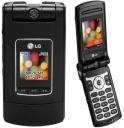 This Bluetooth wireless mouse/keyboard (HID device) includes a laser pointer, five way joystick style mouse, and two option buttons. The mouse portion works basically out of the box with my linux laptop.
This Bluetooth wireless mouse/keyboard (HID device) includes a laser pointer, five way joystick style mouse, and two option buttons. The mouse portion works basically out of the box with my linux laptop.
Category Archives: Linux
Upgrading the miniPCI wireless card in a Thinkpad X31
A few years ago when I first bought it, I installed a Lucent Technologies Prism based mini-pci wifi card in my IBM/Lenovo Thinkpad X31 laptop because the prism chipset had good linux support. But, it does not support WPA2 encryption. I decided the easiest fix was to upgrade to an Intel Pro/Wireless 2100 Lan adapter, which is now supported and works with the wpa_supplicant program to support WPA2 encryption.
The only problem I ran into durring the procedure was that my laptop BIOS had a "whitelist" of approved cards (those sold by IBM) and when I booted it after installing the new card a warning message came up as follows:
ERROR
1802: Unauthorized network card is plugged in – Power off and remove the miniPCI network card.
and, the laptop wouldn't boot. (I just LOVE vendor lock in….)
Luckily, somebody had already figured out how to disable the BIOS whitelist and I found the following program in the Linux Kernel Mailing List archive here: http://lkml.org/lkml/2004/6/13/69
Finding hosts in new known_hosts files which are hashed
Older versions of SSH kept a ~/.ssh/known_hosts file which contained the name of each server you had connected to, along with it's public key. If you ever wanted to erase a public key, you simply edited the file with your favorite text editor, found the name of the server, and then deleted that line. (You might do this for example if the server admin had changed the public key of the server, and you wanted to tell SSH that it was ok to grab the new key and use it instead of the old key.)
New versions of SSH store the server name in a hashed form, so you can't visually identify it (it's not human readable). This is a security feature so that somebody with access to you known_hosts file can't figure out what other machines you have connected to (and that they should try to hack next, etc). But it makes your job harder when you want to delete a single host's key.
The inelegant solution is to just delete the whole file and then accept new keys from everybody, but this is a security risk. To find out which hashed entry matches the server whose key you are trying to replace, simply run the following command:
ssh-keygen -F servername.com
Or, even better, to simply remove the server from your known_hosts file all in one command, use:
ssh-keygen -R servername.com
Linux OBEX Push via bluetooth to the V3xx
I recently had trouble using the standard kbluetoothd and KDE OBEX file push client to send a movie to my Motorola V3xx cell phone over bluetooth. The transfers would be denied with no explanation. I decided to try the command line tool obexpush (written my Marcel Holtmann of the BlueZ project) to see if I could get a better error message. Continue reading
LG CU-500 Mobile Phone Review (Cingular)
 The LG CU500 Phone is one of Cingular's new non-smart 3G phones, and can be purchased relatively inexpensively with a contract. (Amazon sells them for 0.01 with a 2 year contract, cingular charged $50 the last time I checked.) Although it doesn't have a mini-qwerty keyboard and good email support like the Blackjack, 8525, or Treo 750, it also costs $200-400 less. The LG CU500 is in the same class as the Samsung A707 SYNC and the Motorola RAZR V3xx in that it supports 3G, playing music, and Cingular videos.
The LG CU500 Phone is one of Cingular's new non-smart 3G phones, and can be purchased relatively inexpensively with a contract. (Amazon sells them for 0.01 with a 2 year contract, cingular charged $50 the last time I checked.) Although it doesn't have a mini-qwerty keyboard and good email support like the Blackjack, 8525, or Treo 750, it also costs $200-400 less. The LG CU500 is in the same class as the Samsung A707 SYNC and the Motorola RAZR V3xx in that it supports 3G, playing music, and Cingular videos.
Continue reading
Creating udev rules to name your devices in Mandriva
I have a Motorola cell phone, and when it is plugged into my linux laptop via a USB cable it appears as a /dev/ttyACM0 device. (Unless I already have an ACM device plugged in, then it appears as /dev/ttyACM1). BUT, it's much nicer to be able to point my phone programs (such as kmobiletools and moto4lin) at a logical device, such as /dev/mobile where the number won't change than to point it at the kernel device name.
Converting a movie (.avi) to play on a cell phone (.3gp) on Mandriva Linux
I created this script which will convert a movie to play on a cell phone (.3gp format). It works on Mandriva linux, and uses ffmpeg (because my version of mp4creator didn't work).
Fixing a GRUB Bootloader (What to do when your computer won’t boot!)
If, for some reason your linux computer won't boot, it could be because the bootloader has gotten correupted. If you are using GRUB, a few things could have gone wrong, but I will describe how to do a complete re-install of grub, and then set up the boot menu again. The system I was working on was Ubuntu 6.10. Continue reading
D-Link DWL-G122 works with Mandriva Linux
I purchased a D-Link DWL-G122 802.11g USB Adapter to use with my Mandriva Linux based router and was pleased to find that it worked out of the box. (I was also pleased to find a desk dock for USB sticks included in the box.) Mandriva installed a wireless Ethernet device named "rausb0" which worked just as well as my standard eth2 (built in mini-pci prism card). I verified that the network connection worked with both an access point (managed) network and an ad-hoc network. Continue reading
Running a physical Windows (XP) partition in VMware from Linux
For the last month I have been able to boot and run my laptop's Windows partition from inside a vmware server that runs under my (dual boot) Mandriva Linux partition. This is very useful when I need to run something in windows but don't want to shut down Linux and reboot.
I found the instructions on Scott Bronson's blog to be accurate and complete!